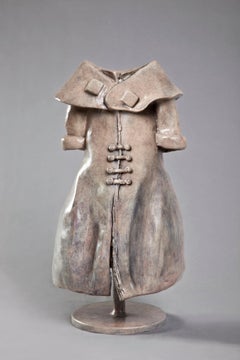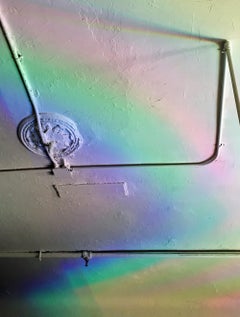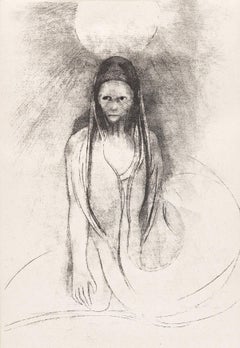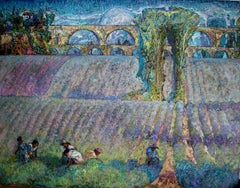Symbolist Art
to
242
572
102
156
48
76
Overall Width
to
Overall Height
to
2
105
643
207
26
104
112
92
13
13
23
18
52
13
115,204
65,049
54,259
26,900
14,895
9,092
6,101
5,721
4,201
3,041
2,608
2,293
2,226
709
603
266
67
569
356
235
184
182
110
101
57
49
48
46
38
33
30
26
25
21
20
20
19
258
227
157
155
137
96
42
38
37
34
127
438
540
256
Style: Symbolist
Anita Birkenfeld, Dress, garment sculpture, Bronze sculpture
Located in Tel Aviv, IL
Anita Birkenfeld, Bronze sculpture, figurative sculpture, soul, Garment, Israeli art, Israeli artist
Category
2010s Symbolist Art
Materials
Bronze
Andra Samelson, Jalü #7, archival pigment print, on canvas, Ed. 1/5, Rainbows
Located in Darien, CT
Rainbow Light can manifest anywhere and anytime, representing ominscience and it can dissolve instantly, representing impermanence. It is without shadow and represents awareness with...
Category
2010s Symbolist Art
Materials
Archival Pigment
Andra Samelson, Jalü #5 archival pigment print on canvas, Ed. 1/5, Rainbows
Located in Darien, CT
Rainbow Light can manifest anywhere and anytime, representing ominscience and it can dissolve instantly, representing impermanence. It is without shadow and represents awareness with...
Category
2010s Symbolist Art
Materials
Archival Pigment
L'Intelligence fut a moi! Je devins le Buddha
By Odilon Redon
Located in New York, NY
A very good impression of this lithograph on Chine appliqué. Edition of 50. Printed by Blanchard, Paris. Published by Vollard, Paris. From "La Tentation de Saint-Antoine (Troisième s...
Category
1890s Symbolist Art
Materials
Lithograph
Patricia Fabricant, Blue Jellyfish 4, 2003, Oil On Canvas, 24 x 24, Naturalism
Located in Darien, CT
Patricia Fabricant is a painter curator, and award-winning book designer, born in New York City. She received her BA from Wesleyan University and studied painting in Florence Italy. Her abstract and figurative paintings have been exhibited widely at such galleries as ODETTA, M David & Co, Front Room, SFA Projects, Equity Gallery, Morgan Lehman, the Painting Center, and 490 Atlantic. Her curatorial practice includes three editions of the benefit group show, Among Friends, Studio Mates at Front Room Gallery, and With the Grain, at Equity Gallery. She lives and works in Brooklyn, NY.
Patricia Fabricant has a deep and abiding interest in process-driven work, from mandalas and yantras to Aboriginal song-line paintings, Islamic tiles...
Category
2010s Symbolist Art
Materials
Canvas, Oil
In the Edge of Poussin and Van Gogh - Green White Brown Grey Purple Blue Yellow
Located in Sofia, BG
"In the edge of Poussin and Van Gogh" is a still-life painting by the impressionist Alexandr Reznichenko.
About the artwork:
TECHNIQUE: oil painting
STYLE: Impressionist, Contempo...
Category
2010s Symbolist Art
Materials
Canvas, Oil
Andra Samelson, Jalü #5 archival pigment print, Ed. 3/5, Rainbows reflections
Located in Darien, CT
Rainbow Light can manifest anywhere and anytime, representing ominscience and it can dissolve instantly, representing impermanence. It is without shadow and represents awareness with...
Category
2010s Symbolist Art
Materials
Archival Pigment
Denise Jones Adler, Phases of the Moon, 2018, Mixed Media on Wood, Mystical
Located in Darien, CT
Denise Jones Adler's work is both personal and archetypical and seeks to memorialize a moment in time, the fragile nature of life, and the emotional impact of the past on the present. Her portraits and dreamscapes pinpoint an unsettled view of the world, layered with a subtle sense of amusement and innate feminism.
Adler is influenced by the Feminist Art Movement as well as Expressionism and the Dada movement. The collages of Hannah Hoch...
Category
2010s Symbolist Art
Materials
Linen, Mixed Media, Acrylic
Andra Samelson, Jalü #7, archival pigment print, Ed. 1/5, Rainbows reflections
Located in Darien, CT
Rainbow Light can manifest anywhere and anytime, representing ominscience and it can dissolve instantly, representing impermanence. It is without shadow and represents awareness with...
Category
2010s Symbolist Art
Materials
Archival Pigment
The Thoughts - Etching by André Suares - 1926
Located in Roma, IT
The Thoughts is from Illustrations for Cressidra, a print on paper realized by André Suares in 1926.
Etching and drypoint
Edition of 200 print
Good conditions.
Category
1920s Symbolist Art
Materials
Etching, Drypoint
Amour - Etching by André Suares - 1926
Located in Roma, IT
Amour is from Illustrations for Cressidra, a print on paper realized by André Suares in 1926.
Etching and drypoint
Edition of 200 print
Good conditions.
Category
1920s Symbolist Art
Materials
Etching, Drypoint
The Dinner Gathering - Etching by André Suares - 1926
Located in Roma, IT
The Dinner Gathering is from Illustrations for Cressidra, a print on paper realized by André Suares in 1926.
Etching and drypoint
Edition of 200 print
Good conditions.
Category
1920s Symbolist Art
Materials
Etching, Drypoint
Lovers - Etching by André Suares - 1926
Located in Roma, IT
Lovers is from Illustrations for Cressidra, a print on paper realized by André Suares in 1926.
Etching and drypoint
Edition of 200 print
Good conditions.
Category
1920s Symbolist Art
Materials
Etching, Drypoint
Love Story - Etching by André Suares - 1926
Located in Roma, IT
Love story is from Illustrations for Cressidra, a print on paper realized by André Suares in 1926.
Etching and drypoint
Edition of 200 print
Good conditions.
Category
1920s Symbolist Art
Materials
Etching, Drypoint
Disastrous - Etching by André Suares - 1926
Located in Roma, IT
Disastrous is from Illustrations for Cressidra, a print on paper realized by André Suares in 1926.
Etching and drypoint
Edition of 200 print
Good conditions.
Category
1920s Symbolist Art
Materials
Etching, Drypoint
Lady and Handmaiden - Etching by André Suares - 1926
Located in Roma, IT
Lady and Handmaiden is from Illustrations for Cressidra, a print on paper realized by André Suares in 1926.
Etching and drypoint
Edition of 200 print
Good conditions.
Category
1920s Symbolist Art
Materials
Etching, Drypoint
Lady and Handmaiden - Etching by André Suares - 1926
Located in Roma, IT
Lady and Handmaiden is from Illustrations for Cressidra, a print on paper realized by André Suares in 1926.
Etching and drypoint
Edition of 200 print
Good conditions.
Category
1920s Symbolist Art
Materials
Etching, Drypoint
Half Moon - Etching by André Suares - 1926
Located in Roma, IT
Half Moon is from Illustrations for Cressidra, a print on paper realized by André Suares in 1926.
Etching and drypoint
Edition of 200 print
Good conditions.
Category
1920s Symbolist Art
Materials
Etching, Drypoint
Ruines du Chateau de Tancarville by Alfred-Luois Burnet Debaines - 1860s
Located in Roma, IT
Ruines du Chateau de Tancarville is a black and White etching realized by Alfred-Luois Burnet Debaines in the 1860s.
Titled in the lower.
Image size: 31x22.
Very good impression ...
Category
1860s Symbolist Art
Materials
Etching
Andra Samelson, Jalü #6 archival pigment print, Ed. 1/5, Rainbows reflections
Located in Darien, CT
Rainbow Light can manifest anywhere and anytime, representing ominscience and it can dissolve instantly, representing impermanence. It is without shadow and represents awareness with...
Category
2010s Symbolist Art
Materials
Archival Pigment
The Water Carrier - Etching by A. Suares - 1926
Located in Roma, IT
The Water Carrier, Illustration for Cressidra, is a print on paper realized by tAndré Suares in 1926.
Etching and drypoint
Edition of 200 print.
Good conditions.
Category
1920s Symbolist Art
Materials
Etching, Drypoint
Colosseum - Etching by Antonio Carbonati - 1947
Located in Roma, IT
Colosseum is a modern artwork realized by Antonio Carbonati in 1947.
Black and white etching
Includes passepartout
Hand signed and dated on the lower margin
Original title: Colosseo Palatino Celio Via dei Trionfi dai balconi di casa Carcano sul Colle Aventino
Good conditions except for yellowing of paper.
Antonio Carbonati (1893 - 1956). He published a series of engravings of Rome...
Category
1920s Symbolist Art
Materials
Etching
Nude - Etching by A. Suares - 1926
Located in Roma, IT
Nude is from Illustrations for Cressidra, a print on paper realized by André Suares in 1926.
Etching and drypoint
Edition of 200 print, Including a Passepartout
Good conditions.
Category
1920s Symbolist Art
Materials
Etching, Drypoint
The Bath - Etching by A. Suares - 1926
Located in Roma, IT
The Bath is from Illustrations for Cressidra, a print on paper realized by André Suares in 1926.
Etching and drypoint
Edition of 200 print, Including a Passepartout
Good conditions.
Category
1920s Symbolist Art
Materials
Etching, Drypoint
Nudes - Etching by A. Suares - 1926
Located in Roma, IT
Nudes is from Illustrations for Cressidra, a print on paper realized by André Suares in 1926.
Etching and drypoint
Edition of 200 print, Including a Passepartout
Good conditions.
Category
1920s Symbolist Art
Materials
Etching, Drypoint
Lady - Etching by A. Suares - 1926
Located in Roma, IT
Lady is from Illustrations for Cressidra, a print on paper realized by André Suares in 1926.
Etching and drypoint
Edition of 200 print, Included a Passepartout.
Good conditions.
Category
1920s Symbolist Art
Materials
Etching, Drypoint
Lovers - Etching by A. Suares - 1926
Located in Roma, IT
Lovers is from Illustrations for Cressidra, a print on paper realized by André Suares in 1926.
Etching and drypoint
Edition of 200 print, Including a Passepartout.
Good condition...
Category
1920s Symbolist Art
Materials
Etching, Drypoint
Lovers on Horse - Etching by A. Suares - 1926
Located in Roma, IT
Lovers on Horse from Illustrations for Cressidra, is a print on paper realized by André Suares in 1926.
Etching and drypoint
Edition of 200 print. Including a Passepartout.
Good ...
Category
1920s Symbolist Art
Materials
Etching, Drypoint
The Dream - Etching by A. Suares - 1926
Located in Roma, IT
The Dream is from Illustrations for Cressidra, a print on paper realized by André Suares in 1926.
Etching and drypoint
Edition of 200 print, Including a Passepartout
Good conditi...
Category
1920s Symbolist Art
Materials
Etching, Drypoint
Ex Libris - Etching by Michel Fingesten - 1990s
Located in Roma, IT
"Ex Libris" 1990s is a woodcut on ivory-colorated paper by Anonymous Artist of the 20th Century. Illegible Hand signed and with hand notes in pencil.
In excellent conditions: As go...
Category
1990s Symbolist Art
Materials
Etching
Umzugsanzeige - Etching by Michel Fingesten - 1930s
Located in Roma, IT
"Umzugsanzeige" is a woodcut on ivory-colorated paper by Michel Fingesten, Early 20th Century. Hand signed and with hand notes in pencil.
In excellent conditions: As good as new.
...
Category
1930s Symbolist Art
Materials
Etching
Ex Libris et Musicis Gheri - Etching by Michel Fingesten - 1930s
Located in Roma, IT
"Ex Libris et Musicis Gheri" is an etching on ivory-colorated paper by Michel Fingesten, Early 20th Century. Hand signed in pencil.
In excellent conditions
Michel Fingesten (1884 ...
Category
1930s Symbolist Art
Materials
Etching
Ex Libris - Mantero - Etching by Michel Fingesten - 1930s
Located in Roma, IT
"Ex Libris - Mantero" is an etching on ivory-colorated paper by Michel Fingesten, Early 20th Century. Hand signed in pencil.
In excellent conditions: As good as new.
Michel Finge...
Category
1930s Symbolist Art
Materials
Etching
The Lady and Mirror - Etching by A. Suares - 1926
Located in Roma, IT
The Lady and Mirror is from Illustrations for Cressidra, a print on paper realized by André Suares in 1926.
Etching and drypoint
Edition of 200 print, Including a Passepartout
G...
Category
1920s Symbolist Art
Materials
Etching
Lovers - Etching by André Suares - 1926
Located in Roma, IT
Lovers is from Illustrations for Cressidra, a print on paper realized by André Suares in 1926.
Etching and drypoint
Edition of 200 print, Including a Passepartout
Good conditions.
Category
1920s Symbolist Art
Materials
Etching
Ladies - Etching by André Suares - 1926
Located in Roma, IT
Ladies is from Illustrations for Cressidra, a print on paper realized by André Suares in 1926.
Etching and drypoint
Edition of 200 print, Including a Passepartout
Good conditions.
Category
1920s Symbolist Art
Materials
Etching
Landscape - Etching by André Suares - 1926
Located in Roma, IT
The Landscape is from Illustrations for Cressidra, a print on paper realized by André Suares in 1926.
Etching and drypoint
Edition of 200 print, Including a Passepartout
Good con...
Category
1920s Symbolist Art
Materials
Etching
Lovers - Etching by André Suares - 1926
Located in Roma, IT
Lovers is from Illustrations for Cressidra, a print on paper realized by André Suares in 1926.
Etching and drypoint
Edition of 200 print, Including a Passepartout
Good conditions.
Category
1920s Symbolist Art
Materials
Etching
Ex Libris - Etching by Michel Fingesten - 1930s
Located in Roma, IT
"Ex Libris" is an Etching, Ex Libris, on ivory-colorated paper by Michel Fingesten .
In excellent conditions: As good as new.
Hand-signed in pencil, on the lower right.
Michel Fin...
Category
1930s Symbolist Art
Materials
Etching
Ex Libris - Etching by Michel Fingesten - 1930s
Located in Roma, IT
"Ex Libris" is an Etching, Ex Libris, on ivory-colorated paper by Michel Fingesten .
In excellent conditions: As good as new.
Not signed.
Michel Fingesten (1884 - 1943) was a Czec...
Category
1930s Symbolist Art
Materials
Etching
"In Company of Pigeons" Figurative Painting 56" x 64" inch by Ahmed Saber
By Ahmed Saber
Located in Culver City, CA
"In Company of Pigeons" Figurative Painting 56" x 64" inch by Ahmed Saber
acrylic, ink & silver leaf on wood
AHMED SABER - BIO
Ahmed Saber is an Egyptian artist...
Category
21st Century and Contemporary Symbolist Art
Materials
Silver
Ophelia - Painting Blue Grey Brown Orange Yellow White Black Sand
Located in Sofia, BG
"Ophelia" is a painting by Maestro Edele Bessy - MABILLOT GRANDJEAN GENEVIEVE
The painting is unframed.
Her paintings bring emotion of happiness, love, energy and beauty represented by the vast creative power of her talent.”
Dear art lovers,
if you like the art of maestro Bessy, please click the link to follow this artist and art gallery Snow Pearl to discover all our artists and beautiful artworks.
Thank you so much! we appreciate your interest to our work.
Maestro Edele Bessy was born on August 7, 1946. Self-taught painter since 1982. At first she mainly worked in miniature on ivory, which she then abandoned in favor of oil painting.
New beings appear unconsciously on his canvases taking on the dimension of a wandering crowd, mostly women whose eyes arise and challenge us with ever so much acuity.
Maestro Bessy paints in a very personal, constantly evolving style.
Maestro MABILLOT GRANDJEAN GENEVIEVE - ADELE BESSY
Awards :
Prix de Peinture du Salon de Beauchamp 2023
Médaille du Conseil Départemental de Bourg la Reine 2023
Prix de peinture Salon des Amis des Arts de Chaville 2022
Prix de peinture Salon des beaux-arts de Boulogne-Billancourt 2022
2ème Prix de Peinture Salon de Chablis 2022
Prix de la ville Salon du SPAM Pontoise 2021
Grand Prix de Peinture de SEMEAC 2021
Prix du Jury indépendant Etampes 2021
Prix du conseiller Départemental Salon de Croissy sur seine 2019
Médaille de la ville de St Maurice 2019
Prix du Jury Gagny 2019
1er Prix de peinture Salon des Artistes indépendants Normands 2018
Prix du Jury Salon de Champagne sur Oise 2018
2ème Prix de Peinture Salon de Bois Colombe 2018
Diplôme d'Honneur et Médaille de la ville de Livry-Gargan2017
Prix Univers des Arts Salon de Thionville 2017
Prix de peinture Salon du Plessis Bouchard 2017
Médaille d'Or Salon de Taverny 2017
Prix de Peinture Salon de Sannois 2016
Médaille d’Or Salon de Bondy 2016
Prix de la peinture à l’Huile Ste Maure de Touraine 2016
2ème Prix de Peinture Pont des Arts Vire Normandie 2016
Médaille d’Argent Salon de Cormeilles en Parisis 2016
Prix de Peinture Salon de Guyancourt 2015
Prix du Public Coye la Forêt 2015
Grand Prix du Salon de Roissy en France 2015
L’école de la Loire Prix de Composition Fantastique 2015
L’école de la Loire Grand Prix du Conseil Général 2015
Prix du Public Salon de Plaisir 2014
Prix du Jury Salon de Coye la Forêt 2014
Prix du Bateau Atelier Salon de Bennecourt 2014
Prix du Jury Salon d’Etampes 2014
1er Prix de Peinture de la Municipalité de Taverny 2014
1er Médaille d’Or Salon de Vittel 2014
Prix de la Municipalité de Viarmes 2013
Prix du Public Salon de Gouvieux 2013
Prix de Peinture Salon de Magny en Vexin 2013
Prix de Peinture Salon de Pontoise 2013
1er Prix de Peinture Salon Formes et Couleurs Vélizy Villacoublay 2013
Médaille de la Ville Mantes la Ville 2013
Prix du Jury Salon de Bernay 2012
Prix de Peinture Salon de Montmagny 2012
Prix de Peinture Salon de Rouen 2012
Grand Prix de Peinture de St Aubin...
Category
2010s Symbolist Art
Materials
Canvas, Oil
Fallen Rider from Intermezzi - Etching by Max Klinger - 1881
By Max Klinger
Located in Roma, IT
Fallen Rider from Intermezzi belongs to a series of prints called Intermezzi realized by Max Klinger, published by Nurnberg: Stroefer, 1881.
Etching on paper.
Signed on the plate
...
Category
1880s Symbolist Art
Materials
Etching
Opus IV Unter den Soldaten Rad - Etching by Max Klinger - 1881
By Max Klinger
Located in Roma, IT
Opus IV Unter den Soldaten Rad belongs to a series of prints called Intermezzi realized by Max Klinger, published by Nurnberg: Stroefer, 1881.
Etching on paper.
Signed on the plate...
Category
1880s Symbolist Art
Materials
Etching
"Mules" Figurative Painting (FRAMED) 39" x 59" inch by Ahmed Saber
By Ahmed Saber
Located in Culver City, CA
"Mules" Figurative Painting (FRAMED) 39" x 59" inch by Ahmed Saber
Medium: watercolor on paper
AHMED SABER - BIO
Ahmed Saber is an Egyptian artist based in Luxor in Upper Egypt, wh...
Category
21st Century and Contemporary Symbolist Art
Materials
Paper, Watercolor
Bellatrix - Painting Blue Grey Brown Orange Yellow White Black Pink
Located in Sofia, BG
"Bellatrix" is a painting by Maestro Edele Bessy - MABILLOT GRANDJEAN GENEVIEVE
The painting is unframed.
Her paintings bring emotion of happiness, love, energy and beauty represented by the vast creative power of her talent.”
Dear art lovers,
if you like the art of maestro Bessy, please click the link to follow this artist and art gallery Snow Pearl to discover all our artists and beautiful artworks.
Thank you so much! we appreciate your interest to our work.
Maestro Edele Bessy was born on August 7, 1946. Self-taught painter since 1982. At first she mainly worked in miniature on ivory, which she then abandoned in favor of oil painting.
New beings appear unconsciously on his canvases taking on the dimension of a wandering crowd, mostly women whose eyes arise and challenge us with ever so much acuity.
Maestro Bessy paints in a very personal, constantly evolving style.
Maestro MABILLOT GRANDJEAN GENEVIEVE - ADELE BESSY
Awards :
Prix de Peinture du Salon de Beauchamp 2023
Médaille du Conseil Départemental de Bourg la Reine 2023
Prix de peinture Salon des Amis des Arts de Chaville 2022
Prix de peinture Salon des beaux-arts de Boulogne-Billancourt 2022
2ème Prix de Peinture Salon de Chablis 2022
Prix de la ville Salon du SPAM Pontoise 2021
Grand Prix de Peinture de SEMEAC 2021
Prix du Jury indépendant Etampes 2021
Prix du conseiller Départemental Salon de Croissy sur seine 2019
Médaille de la ville de St Maurice 2019
Prix du Jury Gagny 2019
1er Prix de peinture Salon des Artistes indépendants Normands 2018
Prix du Jury Salon de Champagne sur Oise 2018
2ème Prix de Peinture Salon de Bois Colombe 2018
Diplôme d'Honneur et Médaille de la ville de Livry-Gargan2017
Prix Univers des Arts Salon de Thionville 2017
Prix de peinture Salon du Plessis Bouchard 2017
Médaille d'Or Salon de Taverny 2017
Prix de Peinture Salon de Sannois 2016
Médaille d’Or Salon de Bondy 2016
Prix de la peinture à l’Huile Ste Maure de Touraine 2016
2ème Prix de Peinture Pont des Arts Vire Normandie 2016
Médaille d’Argent Salon de Cormeilles en Parisis 2016
Prix de Peinture Salon de Guyancourt 2015
Prix du Public Coye la Forêt 2015
Grand Prix du Salon de Roissy en France 2015
L’école de la Loire Prix de Composition Fantastique 2015
L’école de la Loire Grand Prix du Conseil Général 2015
Prix du Public Salon de Plaisir 2014
Prix du Jury Salon de Coye la Forêt 2014
Prix du Bateau Atelier Salon de Bennecourt 2014
Prix du Jury Salon d’Etampes 2014
1er Prix de Peinture de la Municipalité de Taverny 2014
1er Médaille d’Or Salon de Vittel 2014
Prix de la Municipalité de Viarmes 2013
Prix du Public Salon de Gouvieux 2013
Prix de Peinture Salon de Magny en Vexin...
Category
2010s Symbolist Art
Materials
Canvas, Oil
Identity + The Sum of Parts
Located in Santa Monica, CA
Acrylic, plastic, modeling paste on canvas
Category
21st Century and Contemporary Symbolist Art
Materials
Acrylic
$400 Sale Price
20% Off
"Jungle Law" Black and White Lithograph by Orovida Camille Pissarro 14/45
Located in Pasadena, CA
This black-and-white lithograph, numbered 14/45, is the work of Orovida, whose real name is Camille Orovida Pissarro. The rectangular framing tightens the composition around three fi...
Category
Mid-20th Century Symbolist Art
Materials
Lithograph
"Angel" Portrait Diptych Painting 18" x 33" inch by Ahmed Saber
By Ahmed Saber
Located in Culver City, CA
"Angel" Portrait Diptych Painting 18" x 33" inch by Ahmed Saber
Diptych
AHMED SABER - BIO
Ahmed Saber is an Egyptian artist based in Luxor in Upper Egypt, where he received his BFA ...
Category
21st Century and Contemporary Symbolist Art
Materials
Ink, Acrylic
Spoke 1, nude, blue tones, suggests sky water
By Tom Bennett
Located in Brooklyn, NY
Oil painting of semi-abstracted female nude against a moody, ambiguous cloudy sky. The figure appears both an ethereal part of and emerging from another world.
Category
2010s Symbolist Art
Materials
Canvas, Oil
Kali, colorful, bold, spiritual, East Indian influence, fire, goddess
By Janet Morgan
Located in Brooklyn, NY
Acrylic on theatrical backdrop muslin, can be rolled, rod pockets top and bottom for hanging.
This painting was featured at the Parliament of World Religions in Toronto in 2018. Kali is the goddess of eternal energy, creation and destruction. She covers it all.
Janet has both shown and taught with Alex...
Category
2010s Symbolist Art
Materials
Fabric, Acrylic
Ex Libris - Istvan Traurig - Etching by Michel Fingesten - 1930s
Located in Roma, IT
Ex Libris - Istvan Traurig is a Woodcut print created by Michel Fingesten.
Signed on plate on back. The work is glued on cardboard.
Total dimensions: cm 32x24
Good conditions.
...
Category
1930s Symbolist Art
Materials
Etching
$320 Sale Price
20% Off
Ex Libris - Mantero- Etching by Michel Fingesten - 1930s
Located in Roma, IT
Ex Libris - Mantero is an Etching print created by Michel Fingesten.
Hand Signed on the right margin.
Good conditions.
Michel Fingesten (1884 - 1943) was a Czech painter and eng...
Category
1930s Symbolist Art
Materials
Etching
$338 Sale Price
40% Off
Ex Libris - Mary Talbot - Etching by Michel Fingesten - 1930s
Located in Roma, IT
Ex Libris - Mary Talbot is an Etching print created by Michel Fingesten.
Hand Signed on the lower right margin.
Good conditions.
Michel Fingesten (1884 - 1943) was a Czech painte...
Category
1930s Symbolist Art
Materials
Etching
$451 Sale Price
20% Off
Ex Libris L'Amour et la Folie - Ex Libris - Woodcut by Michel Fingesten - 1930s
Located in Roma, IT
Ex Libris L'Amour et la Folie - Ex Libris Jean Brissac is a woodcut print created by Michel Fingesten.
Hand Signed on the lower right margin.
Good conditions.
Michel Fingesten (...
Category
1930s Symbolist Art
Materials
Woodcut
Ex Libris - Woodcut by Michel Fingesten - 1930s
Located in Roma, IT
Ex Libris is a colored woodcut print created by Michel Fingesten.
Hand Signed on the upper margin.
Good conditions.
Michel Fingesten (1884 - 1943) was a Czech painter and engrav...
Category
1930s Symbolist Art
Materials
Woodcut
$414 Sale Price
20% Off
Ex Libris - Eroticis M.B. - Woodcut by Michel Fingesten - 1930s
Located in Roma, IT
Ex Libris - Eroticis M.B. is a colored woodcut print created by Michel Fingesten.
Hand Signed on the lower right margin.
Good conditions.
Michel Fingesten (1884 - 1943) was a C...
Category
1930s Symbolist Art
Materials
Woodcut
$376 Sale Price
20% Off
Ex Libris - Reinheime - Woodcut by Michel Fingesten - 1930s
Located in Roma, IT
Ex Libris - Reinheimer is a colored woodcut print created by Michel Fingesten.
Hand Signed on the lower right margin.
Good conditions.
Michel Fingesten (1884 - 1943) was a Czec...
Category
1930s Symbolist Art
Materials
Woodcut
$414 Sale Price
20% Off
Ex Libris - Salve Pax - Woodcut by Michel Fingesten - 1937
Located in Roma, IT
Ex Libris - Salve Pax is a woodcut print created by Michel Fingesten in 1937.
Hand Signed on the lower right margin.
Good conditions.
Michel Fingesten (1884 - 1943) was a Czech...
Category
1930s Symbolist Art
Materials
Woodcut
Ex Libris - Livio Ghislandi - Woodcut by Michel Fingesten - 1930s
Located in Roma, IT
Ex Libris - Livio Ghislandi is a woodcut print created by Michel Fingesten.
Hand Signed on the lower right margin.
Good conditions.
Michel Fingesten (1884 - 1943) was a Czech ...
Category
1930s Symbolist Art
Materials
Woodcut
Symbolist art for sale on 1stDibs.
Find a wide variety of authentic Symbolist art available for sale on 1stDibs. Works in this style were very popular during the 21st Century and Contemporary, but contemporary artists have continued to produce works inspired by this movement. If you’re looking to add art created in this style to introduce contrast in an otherwise neutral space in your home, the works available on 1stDibs include elements of orange, blue, green, red and other colors. Many Pop art paintings were created by popular artists on 1stDibs, including Michel Fingesten, Abel Pann, Franz von Bayros (Choisi Le Conin), and Ferdinand Hodler & R. Piper & Co.. Frequently made by artists working with Paint, and Oil Paint and other materials, all of these pieces for sale are unique and have attracted attention over the years. Not every interior allows for large Symbolist art, so small editions measuring 1.58 inches across are also available. Prices for art made by famous or emerging artists can differ depending on medium, time period and other attributes. On 1stDibs, the price for these items starts at $55 and tops out at $378,675, while the average work sells for $863.
Recently Viewed
View AllMore Ways To Browse
Mauritz Lindstrom
Maximillien Luce
Michael Budden Central Park
Midcentury Matador Paintings
Mike Wright
Miracle On Ice
Mississippi River Painting
Monarch Of The Glen Painting
Moroccan Paintings Essaouira
Morpho Butterfly Art
Mount Tamalpais
Murray Dessner
Native American Oklahoma
New England Barn
New Orleans Jazz Poster
Niagara Falls Oil
Oil Painting By Alice
Oil Painting Willow Tree





